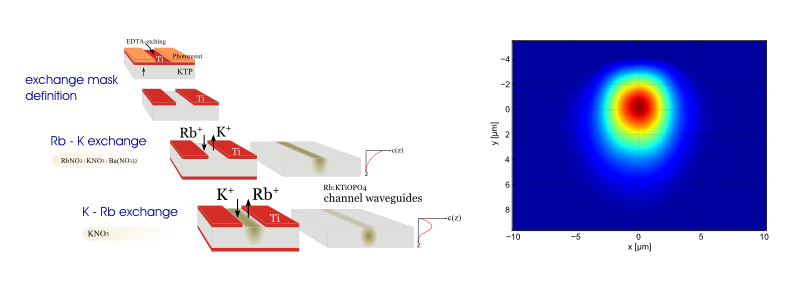Waveguide fabrication in KTP
Potassium titanyl phosphate (KTP) is another interesting nonlinear optical material for integrated quantum optics. It is highly suitable for applications that require short poling periods or high optical damage resistance and provides unique dispersion characteristics. KTP Waveguides of good optical quality can be fabricated by Rb-K-ion exchange [Applied Physics Letters, 50(18):1216, 1987]. They are guiding in both, TE- and TM polarization and, therefore, allow any kind of quasi-phase matching (type 0 - II). Moreover, their dispersive properties are very interesting for ultrafast continuous variable quantum optics. We are currently setting up the technology of ion-exchanged and periodically poled Rb:KTP (Rb:PPKTP-) waveguides.
1.1. Rb-exchanged waveguides in flux-grown KTP (fKTP)
Similar to the proton-exchanged waveguides in Lithiumniobate an exchange mask is photolithographically defined on the KTP-substrate. The Rb-ion exchange is performed in a KNO3- buffered RbNO3-melt at temperatures above 330°C. The duration of the exchange depends on whether buried or non-buried channel waveguides are fabricated.
1.2. Buried Rb-exchanged waveguides in flux-grown KTP (fKTP)
Similar to RPE-waveguides in Lithiumniobate, Rb-exchanged waveguides can be buried using a reversed ion exchange in a K-rich melt. By immersing the as-Rb-exchanged waveguides into a KNO3 melt about 350°C the surface near Rb-profile is depleted by outdiffusion of Rb and indiffusion of K leading to a buried refractive index profile. For such waveguides losses down to 0.2 dB/cm have already been achieved at telecom wavelengths. Fig. 1 (right) shows the near field intensity distribution of a TM-mode at 1530 nm of such a buried 5.5 μm wide channel in Z-cut X-propagation fKTP.

